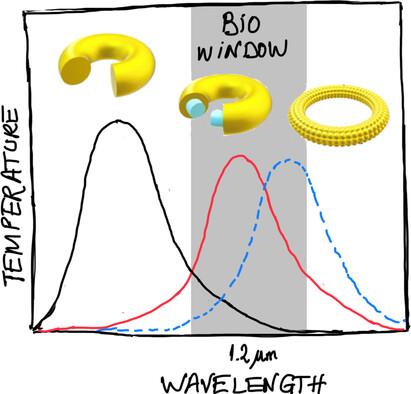On the Photothermal Response of DNA–Au Core/Shell Nanotoroids as Potential Agents for Photothermal Therapies
引用次数: 0
Abstract
Plasmonic nanoparticles play a pivotal role in various research areas due to their exceptional optical and thermo-optical properties, like high spectral tunability and efficient light-to-heat conversion. Gold, with its biocompatibility, low cytotoxicity, and tunable resonances , makes gold nanoparticles ideal for photothermal therapies. Geometries, including spheres, core–shells, rods, disks, stars, nanocages, and nanotoroids, are extensively studied, with the gold nanodoughnut emerging as one of the most promising ones due to its ability to produce high temperatures and rotational stability. Nevertheless, the fabrication of metallic toroidal shapes remains a challenge. Recent advances in DNA-based nanotechnology, especially DNA-origami techniques, provide feasible route for the fabrication of this geometry through metallization reactions or attachment of metal nanoparticles. However, particles manufactured using this method possess a DNA core that influences their thermoplasmonic performance. In this work, a theoretical investigation is conducted on the thermoplasmonic response of DNA-origami-based core/shell toroids (CSTs) for photothermal applications. Key parameters that optimize the CST thermoplasmonic response are identified, and compared with their solid counterparts and discrete metallic coatings. Additionally, the CSTs tolerance to random rotations is assessed, providing insights into their behavior in fluidic environments and implications for its practical consideration.

论 DNA-Au 核/壳纳米多面体作为光热疗法潜在药物的光热反应
质子纳米粒子具有优异的光学和热光学特性,如高光谱可调谐性和高效的光热转换,因此在各种研究领域发挥着举足轻重的作用。金具有生物相容性、低细胞毒性和可调共振等特性,使金纳米粒子成为光热疗法的理想选择。人们对包括球形、核壳形、棒形、盘形、星形、纳米笼形和纳米透镜形在内的各种几何形状进行了广泛研究,其中金纳米圆环因其能够产生高温和旋转稳定性而成为最有前途的几何形状之一。然而,金属环形状的制造仍然是一项挑战。基于 DNA 的纳米技术,特别是 DNA 原形技术的最新进展,为通过金属化反应或金属纳米粒子的附着来制造这种几何形状提供了可行的途径。然而,用这种方法制造的粒子具有 DNA 内核,会影响其热声学性能。在这项工作中,我们对基于 DNA 原型的核/壳环状体(CST)的热光学响应进行了理论研究,以探讨其在光热应用中的作用。研究确定了优化 CST 热弹响应的关键参数,并将其与固态对应物和离散金属涂层进行了比较。此外,还评估了 CST 对随机旋转的耐受性,从而深入了解了它们在流体环境中的行为以及对实际应用的影响。
本文章由计算机程序翻译,如有差异,请以英文原文为准。
求助全文
约1分钟内获得全文
求助全文

 求助内容:
求助内容: 应助结果提醒方式:
应助结果提醒方式:


